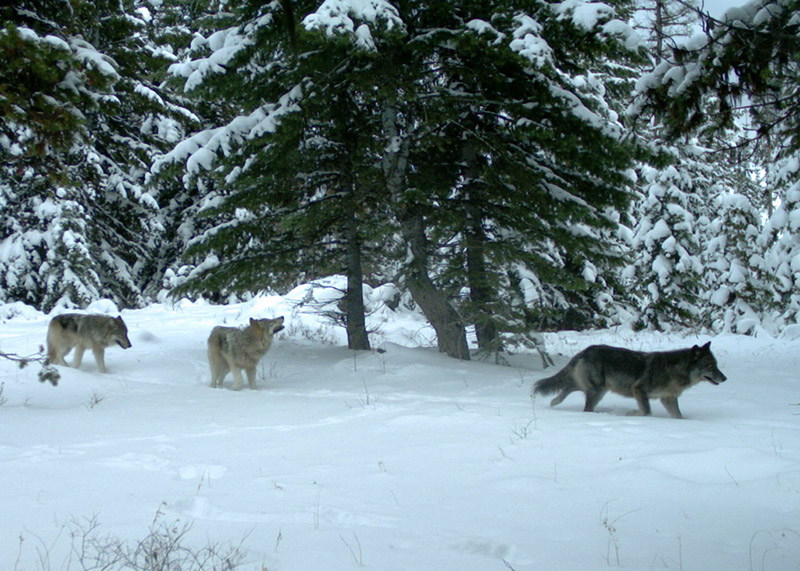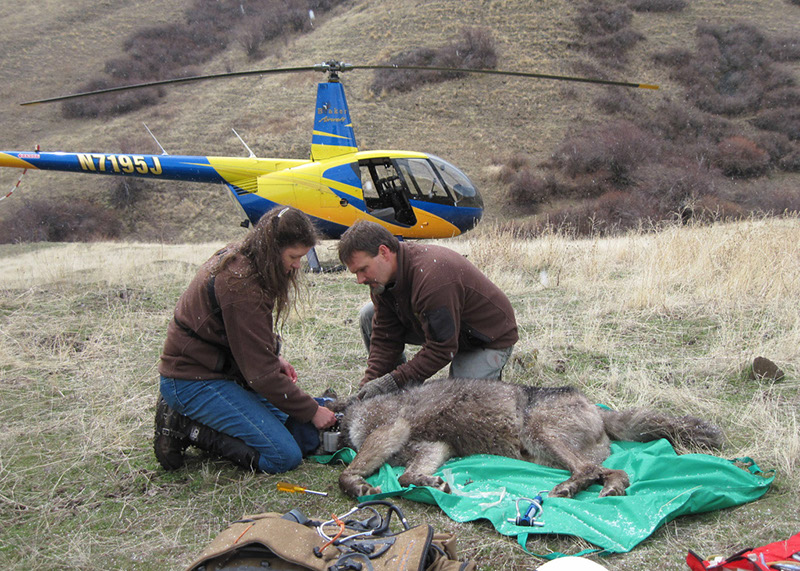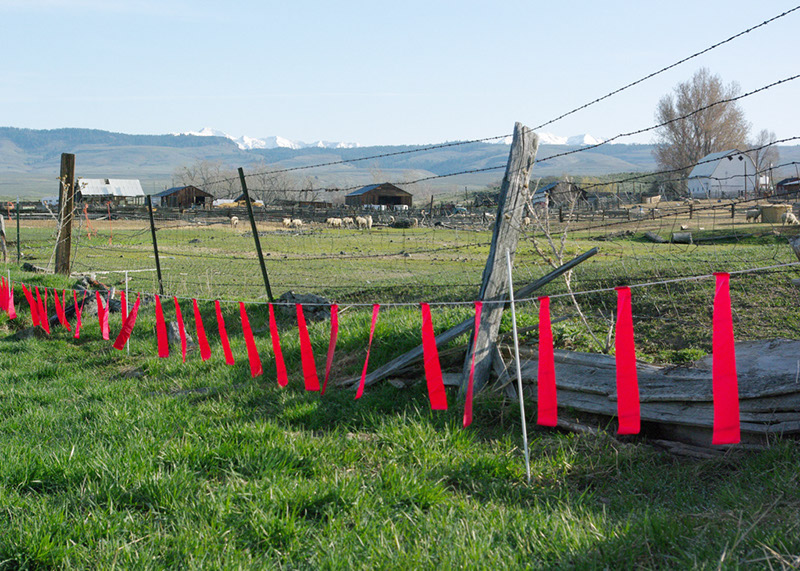
Oregon's Minam wolf pack is relatively new on the scene and, like most Oregon packs, has not come into conflict with humans or their livestock.
We met Rick Lamplugh and his wife on the 2013 Wolf Rendezvous. He is a regular contributor to the Oregon Wild blog and author of the new, bestselling book In the Temple of Wolves: A Winter's Immersion in Wild Yellowstone.
While living and volunteering for three winters in the Lamar Valley, Yellowstone’s wolf country, I sometimes talked with visitors about wolves in Oregon. Some were surprised that Oregon even had wolves. And for more than fifty years we did not. In 1947, Oregon’s last wolf was shot and killed near Crater Lake for a bounty of $5.
Wolves were absent until 1995 when they were reintroduced into neighboring Idaho. Wolves are natural colonizers, and the first one to venture to Oregon doggie paddled across the Snake River from Idaho in 1999. The animal was promptly trapped and sent back by Oregon’s Department of Fish and Wildlife (ODFW). More wolves came with even deadlier results: two were killed by cars and one was shot. Finally, in 2007, a collared Idaho wolf swam, stayed, and survived. By the summer of 2009 Oregon had its first confirmed pack.
By the end of 2013, Oregon’s wolf population had grown to at least 64wolves in eight packs. All of the packs live in the northeastern corner of the state in an area surrounding the small towns of Enterprise and Joseph that is dotted with ranches. Half of the packs have breeding pairs (Defined as an adult male and female with at least two pups by year’s end). Of course, if Oregon’s famous disperser, OR-7, has found a mate, we may soon have a pack in the Oregon Cascades.
With more wolves has come an increase in wolves killing and injuring livestock. Last year that included six sheep, five cows, and one goat. The Imnaha, Snake River, and Umatilla River pack committed all thirteen depredations. All these packs include wolves that wear GPS collars placed by ODFW, as in the photo. Those collars show the animals roamed public and private land.
 Wolves are still protected statewide by Oregon’s Endangered Species Act and in the western part of the state by the Federal ESA. Oregonians have fought to keep our wolves from being killed. In 2011 the ODFW’s authority to kill depredating wolves was challenged in court by Cascadia Wildlands, Oregon Wild, and The Center for Biological Diversity. This led to the court suspending the killing of wolves. In May of 2013 an agreement was reached that ended the lawsuit and led to changes in Oregon’s administrative rules.
Wolves are still protected statewide by Oregon’s Endangered Species Act and in the western part of the state by the Federal ESA. Oregonians have fought to keep our wolves from being killed. In 2011 the ODFW’s authority to kill depredating wolves was challenged in court by Cascadia Wildlands, Oregon Wild, and The Center for Biological Diversity. This led to the court suspending the killing of wolves. In May of 2013 an agreement was reached that ended the lawsuit and led to changes in Oregon’s administrative rules.
One important change was in the definition of depredation. Now packs must be repeat offenders, must have committed at least four confirmed depredations within a six-month period, before any wolves can be killed. Additionally, when a “lethal take order” is issued, the wolf must be killed within 45 days. However, no permit is required to kill a wolf caught in the act of biting, wounding, killing, and chasing livestock or working dogs under certain circumstances.
Under the new wolf rules, ranchers are almost always required to use nonlethal measures before they can kill wolves. In 2013 Oregon’s wolf managers and the state’s ranchers continued implementing nonlethal measures to reduce livestock losses. In fact, the bulk of the money spent by the state last year went to put nonlethal measures into effect.
There are many nonlethal tactics that ranchers anywhere—not just in Oregon—can use. They can increase human presence with guard dogs, range riders, or herders. They can contain livestock at night in small pens rather than leaving them vulnerable in difficult-to-defend pastures. Ranchers can cull weak, injured, or sick animals from the herd since those are wolf favorites. They can remove the carcasses of animals that die of natural causes instead of letting them rot in the field and create bone piles that attract wolves. Ranchers can traintheir cattle to bunch up in smaller, tighter herds, which are less attractive to wolves. They can install fladry, brightly colored flags which are attached to fencing and deter wolves.
 And ranchers can use fright tactics such as installing alarms triggered by the radio collars that some wolves wear, or putting shock collars on wolves that hunt near ranches, or firing nonlethal ammunition like the cracker shells used to haze wolves in Yellowstone.
And ranchers can use fright tactics such as installing alarms triggered by the radio collars that some wolves wear, or putting shock collars on wolves that hunt near ranches, or firing nonlethal ammunition like the cracker shells used to haze wolves in Yellowstone.
In 2013, Oregon’s wolf managers helped ranchers use a variety of such tactics including radio-activated guard devices, radio receivers issued by the state so ranchers can track collared wolves, range riders, fladry, night-penning of sheep, and my favorite, text messaging.
The messaging system utilizes GPS locations from collared wolves and notifies ranchers via text, email, or both when wolves come near their livestock. Ranchers can then send out range riders or use other non-lethal methods to keep wolves and herds apart. By year’s end, more than 83,000 messages were sent. While the system receives good reviews, it isn’t perfect, and some ranchers complain that it only tells them where wolves used to be.
When wolves do kill livestock, Oregon’s ranchers (like those in Montana, Wyoming, and Idaho) can be compensated once the incident is found to be a confirmed or probable wolf kill. The three Oregon counties that requested compensation received their full request. Ranchers were also reimbursed for missing livestock.
Ranchers can even receive a state tax credit for the market value of any livestock that was confirmed as killed by wolves. The Oregon Department of Fish and Wildlife reports that so far no applications for tax credits have been received, but this may change as the tax season progresses.
Oregon’s approach to managing wolves differs markedly from other wolf states—especially in the requirement to use nonlethal methods to keep wolves and livestock separate and alive. I hope that other states use Oregon’s approach as a model.
 Rick Lamplugh is the author of the new bestselling book, In the Temple of Wolves which can found on Amazon at http://amzn.to/Jpea9Q
Rick Lamplugh is the author of the new bestselling book, In the Temple of Wolves which can found on Amazon at http://amzn.to/Jpea9Q
 '
'
